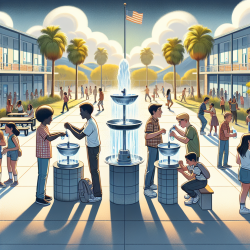Introduction
Access to clean drinking water in schools is essential for promoting health and well-being among students. The research article "Drinking water access in California schools: Room for improvement following implementation of school water policies" sheds light on the significant improvements and ongoing challenges in providing excellent drinking water access in California schools. This blog aims to inspire practitioners to enhance their skills by implementing the research outcomes or encouraging further research.
The Importance of Drinking Water Access
Drinking water instead of sugar-sweetened beverages can help prevent obesity, type 2 diabetes, and dental caries, and improve cognitive function. Many students arrive at school inadequately hydrated, making the promotion of water intake in schools critical to their health. In 2010, California enacted Senate Bill (SB) 1413, mandating free drinking water in food service areas, which was later incorporated into the federal Healthy, Hunger-Free Kids Act (HHFKA).
Research Findings: Progress and Challenges
The study utilized repeated cross-sectional surveys with school administrators from a random sample of California public schools. It assessed excellence in drinking water access based on criteria such as availability in key locations, high density, non-fountain sources, safety, and cleanliness. The results showed a significant increase in schools meeting all excellence criteria from 5% in 2010-2011 to 18% in 2016-2018.
Despite these improvements, a majority of schools still lack excellent water access. The findings suggest that policies mandating free water access in schools can improve access, but more work is needed to help all schools excel in this area.
Implementing the Outcomes
Practitioners can enhance their skills by implementing the following strategies based on the research findings:
- Increase Awareness: Educate school administrators and staff about existing water policies and their importance. Awareness is linked to policy compliance and improved water access.
- Expand Water Access: Ensure water is available not only in cafeterias but also in classrooms, physical activity areas, and other high-traffic locations.
- Promote Non-Fountain Sources: Encourage the use of water stations, pitchers, and hydration stations, which are more appealing and functional than traditional fountains.
- Provide Drinking Vessels: Offer cups or reusable water bottles to increase water consumption among students.
- Ensure Safety and Cleanliness: Regularly test water quality and maintain water sources to ensure they are safe and appealing.
Encouraging Further Research
While significant progress has been made, there is still room for improvement. Practitioners are encouraged to conduct further research to explore innovative ways to enhance water access in schools. This could include studying the impact of different types of water delivery systems or examining the cost-effectiveness of various approaches.
Conclusion
Creating school environments that promote water intake is crucial for students' health and well-being. By implementing the research outcomes and encouraging further exploration, practitioners can contribute to a healthier future for students.
To read the original research paper, please follow this link: Drinking water access in California schools: Room for improvement following implementation of school water policies.










